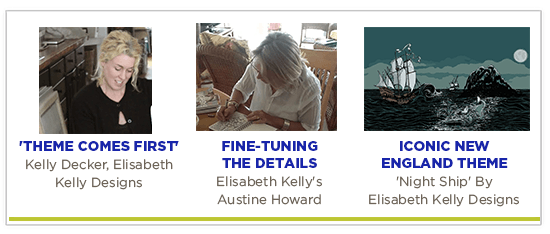Beth Saffer and Suzan Waldinger, Bluebell Design Studios, New York City — Pooling talents and 20+ years’ experience in the art circuit, the Studios already hold several licensing contracts in prints, paper goods, door mats and more that have been seen on QVC, Skymall and Chiasso catalogs, and Wired magazine.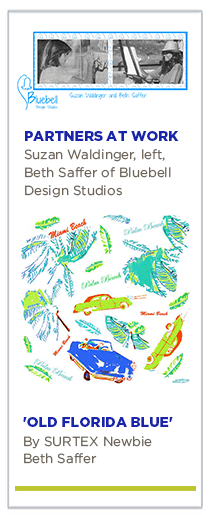
A fine artist, Beth has shown in galleries, art exhibits, and interior design projects — which took her back to school at FIT (Fashion Institute of Technology) in NY, where she “fell madly in love with the design process.”
The two artists met while volunteering with art students, and the rest is about to become history as Bluebell Design Studios debuts at SURTEX.
Q: We asked: Do you try to be on-trend?
A: “If trends happen to mesh with what we are all about…. Sometimes a trend will come along and we already have the art to match. Beth’s passion for all things vintage led her to design retro images long before the modern-vintage trend arrived (and) Suzan’s peace designs were ahead of the trend.”
“When art is created naturally it always has a stronger voice than when it is dictated.”
Q: What trends do you see for 2016 and beyond?
A. “Wearable technology. This will bring new surfaces to explore and cover… and new printing technology…. It is only a matter of time before 3-D printing allows for surface design.
“Another ongoing trend is ‘home’, which will continue to grow as technology advances and people seek solace in and (are able to) work from their homes.”
Elisabeth Kelly Design, Holderness, NH — When is the right time to expand your business horizons? When you are up against a wall, says artist Kelly Decker. And she means that literally.
Seven years ago, she was a single artist, making hand-screened wallpapers, fabrics, and murals popular in homes throughout New England (not to mention California and Australia). Her work soon caught the attention of home decor magazines like Better Homes & Gardens, and Yankee. But it wasNew Hampshire Home magazine that became the catalyst for Kelly’s business leap forward. The magazine featured Austine Howard’s own home, for which she and Kelly worked together to design wallpaper and a mural.
Both accomplished artists, both believing in designing by hand before fine-tuning by computer, the two soon decided they’d “make a great team,” Kelly reports, even if their individual work is very different.
Q: How do two artists with very different styles manage to work together?
A: Having a theme or a focus makes doing the art much easier, they say. “Some designs are elegant, others wilder…some inspired by antique ephemera and historic patterns…some very organic, inspired by nature….”
Q: What is your main objective for SURTEX?
A: “To have our art seen and adored …but also to learn more about the trade, to meet like-minded, creative people, and,” Elisabeth confides, “have a blast.”
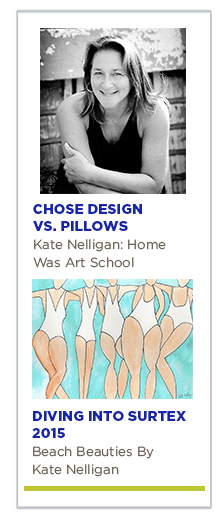 Kate Nelligan, Kate Nelligan Design, Kennebunkport, ME— Still lives and works where she grew up in “a highly creative family — we were taught to make things and entertain ourselves instead of watching television. That was my art school.”
Kate Nelligan, Kate Nelligan Design, Kennebunkport, ME— Still lives and works where she grew up in “a highly creative family — we were taught to make things and entertain ourselves instead of watching television. That was my art school.”
Kate worked in product development and graphic design, until a few years ago, when she designed a fabric collection for pillows, scarves and table linens. “It was a huge success, but I couldn’t keep up!” Kate reports. “I had to decide whether I wanted to manage a pillow factory or be a designer. I chose designer and started licensing with some great companies right away. So far so good!”
Q: What’s the difference in making art for art’s sake and art for sale?
A: It’s fun and actually relaxing to do my own thing…. That’s how I “fill the well” per se. When I’m interpreting my art for licensing, I am always picturing the end customer in the store, reaching for the product I’m designing and being energized and excited about making a purchase.”
Q: What trends do you see for 2016 and beyond?
A: “I think we’re still in digital recovery mode – once we all saw that we could make everything look perfect on the computer, we discovered that the art had no soul. So I think we are going to want to keep seeing the hand of the artist for a very long time to come.”
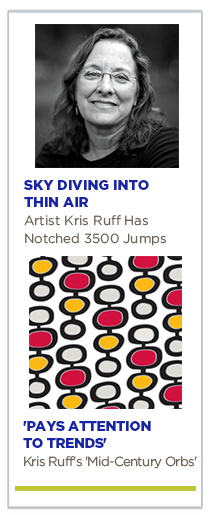
Next came surface designs for coffee mugs, area rugs, wall art, and kitchen linens, all in the signature colorful, contemporary style she says references Scandinavian design and artists like Henri Matisse and Keith Haring.
Q: Your style is so distinctive, do you still follow current trends?
A: “I pay attention to big trends. For example, I designed more floral prints when they were so popular, and now that I’m seeing so many geometrics in the marketplace I’ve added more of those to my portfolio. But beyond that I don’t really follow trends. I work very intuitively, rarely starting with a specific idea, trend or color palette in mind.”
Q: What do you hope to get from the SURTEX experience?
A: “I’ve often read about the camaraderie among exhibitors at SURTEX so that might be what I’m looking forward to most. As much as I love working on my own, it can feel isolating, so spending all those hours surrounded by fellow artists will be wonderful.”
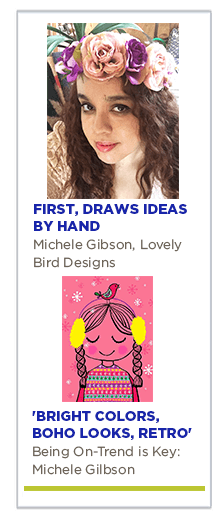 Michele Gibson, Lovely Bird Designs, New York City — Even while she was still a student at the School Of Visual Arts in New York City (where she received her bachelors in Fine Arts), Michele began developing original prints for textile design studios — by hand, she points out: “Computers were still in their infancy.”
Michele Gibson, Lovely Bird Designs, New York City — Even while she was still a student at the School Of Visual Arts in New York City (where she received her bachelors in Fine Arts), Michele began developing original prints for textile design studios — by hand, she points out: “Computers were still in their infancy.”
Michele says she now designs everything on the computer but “I still begin the process by drawing my ideas by hand.” Her client list is a Who’s Who of top retailers, including Kate Spade, Urban Outfitters, Target, Chicos, and the giant “Marts,” Wal and K.
Q: Do you track trends…or always do your own thing?
A: “I have been on both ends of the design industry having to always be out there and shop and spot the latest trends when developing new lines. So being on-trend but still marketable is key to my design studio.”
Q: What trends do you see for 2016 and beyond?
A: Bright colors and boho looks are very much on trend. Ikats, medallions, and retro are also trending now.
Kristen Dettoni and Geraldine Blanchot, Pattern Pod, Brooklyn, NY — They met when they both worked at the same company (True Textiles) and formed a bond, Kristen says, through their “love of design, color, and just being together and having fun.”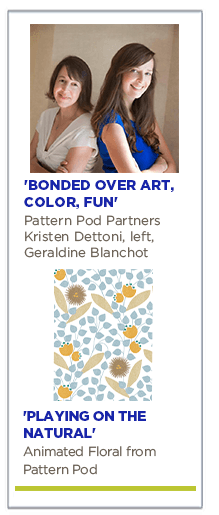
Fun soon turned serious. The friends realized that during their combined 31 years in the textile industry, they have seen more than 1,000 textile mills shut down, leaving 700,000+ unemployed workers to re-educate themselves for different industries. Watching that happen, Kristen and Geraldine decided to take their fate into their own hands… but what to do exactly?
Their answer: utilize the many designs they made that were never placed, some 90 percent of the 300+ designs they produced to meet client demands. That meant thousands of dollars left behind, Kristen explains. “So what do you do? Start a business that utilizes all the designs you produce.”
That was in early 2013. Two years later, capitalizing on their 30+ combined years of working with such clients as Pallas Textiles, Enviroleather, and Douglass Industries, Pattern Pod offers patterns for consulting purposes, proprietary ownership, and royalty-free options for personal use and licensing.
Q: You’ve been tracking trends for a long time. What do you see ahead?
A: Continuing Trends: Geometrics; lace (real and printed); graphics that look hand-drawn and personal, playing on the natural, eg., “farm to table.”
Emerging Trends: Plaids, seen on the runway for both spring and fall; shapes and looks with the feel of animation or comic strips.
Color Trends: Marsala, Pantone’s Color of the Year: will inspire more deep and jewel tones.

